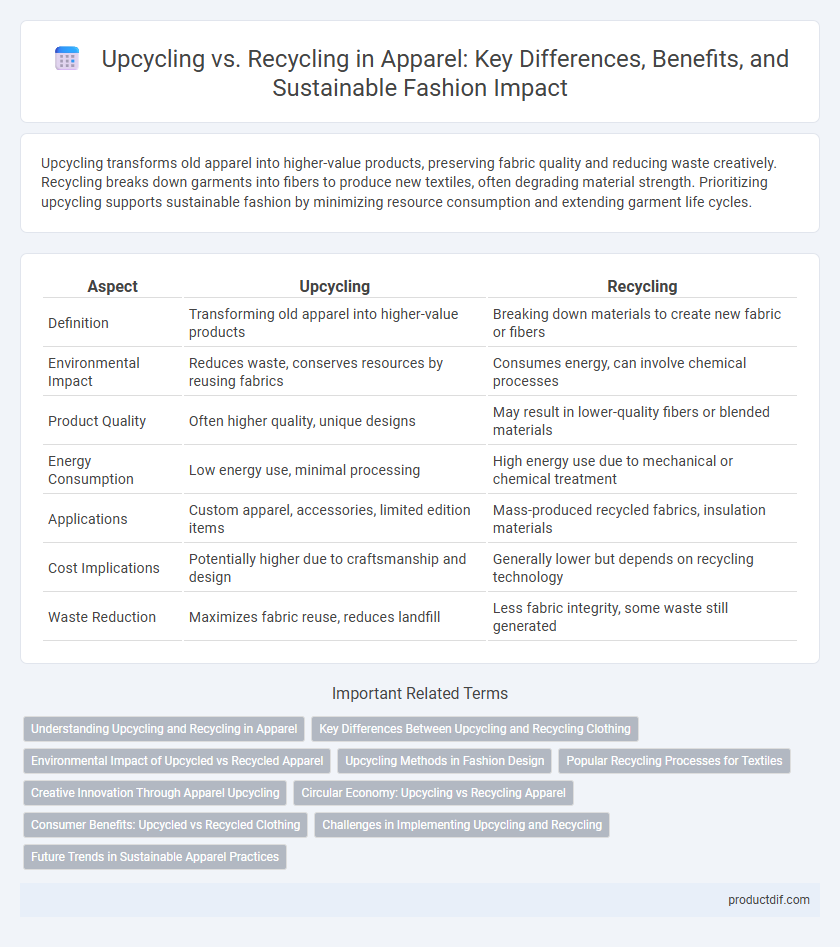Upcycling transforms old apparel into higher-value products, preserving fabric quality and reducing waste creatively. Recycling breaks down garments into fibers to produce new textiles, often degrading material strength. Prioritizing upcycling supports sustainable fashion by minimizing resource consumption and extending garment life cycles.
Table of Comparison
| Aspect | Upcycling | Recycling |
|---|---|---|
| Definition | Transforming old apparel into higher-value products | Breaking down materials to create new fabric or fibers |
| Environmental Impact | Reduces waste, conserves resources by reusing fabrics | Consumes energy, can involve chemical processes |
| Product Quality | Often higher quality, unique designs | May result in lower-quality fibers or blended materials |
| Energy Consumption | Low energy use, minimal processing | High energy use due to mechanical or chemical treatment |
| Applications | Custom apparel, accessories, limited edition items | Mass-produced recycled fabrics, insulation materials |
| Cost Implications | Potentially higher due to craftsmanship and design | Generally lower but depends on recycling technology |
| Waste Reduction | Maximizes fabric reuse, reduces landfill | Less fabric integrity, some waste still generated |
Understanding Upcycling and Recycling in Apparel
Upcycling in apparel involves creatively transforming old or discarded garments into new, higher-quality products, preserving material value and reducing waste. Recycling breaks down fabric fibers to produce raw materials for new textiles, often resulting in lower-quality products but lowering the need for virgin resources. Understanding the distinct processes highlights upcycling's emphasis on design innovation and recycling's focus on material recovery within sustainable fashion practices.
Key Differences Between Upcycling and Recycling Clothing
Upcycling clothing involves creatively transforming old garments into higher-quality or more valuable items without breaking down the original fabric, while recycling breaks down textiles into raw fibers to produce new fabric or materials. Upcycling preserves the garment's structure and design, contributing to waste reduction by extending the item's life cycle, whereas recycling often requires energy-intensive processes and may degrade fiber quality. Brands focusing on sustainability increasingly incorporate upcycling for its environmental benefits and unique product appeal, contrasting with traditional recycling methods commonly used in mass textile waste management.
Environmental Impact of Upcycled vs Recycled Apparel
Upcycled apparel significantly reduces environmental impact by repurposing old garments into new products, minimizing textile waste and lowering carbon emissions compared to recycling processes that often require energy-intensive techniques to break down fibers. Recycling apparel typically involves chemical treatments and mechanical processes that can deplete natural resources and generate pollution, whereas upcycling extends garment life without extensive reprocessing. Choosing upcycled apparel supports sustainable fashion by decreasing landfill contributions and conserving water and energy used in traditional recycling.
Upcycling Methods in Fashion Design
Upcycling in fashion design transforms existing garments or fabric scraps into new, high-value pieces by creatively altering patterns, incorporating embellishments, or combining diverse textiles. Techniques such as patchwork, embroidery, and deconstruction elevate waste materials, reducing the need for virgin resources and minimizing environmental impact. This method enhances sustainability by extending the lifecycle of apparel while promoting unique, one-of-a-kind designs.
Popular Recycling Processes for Textiles
Popular recycling processes for textiles include mechanical recycling, where fabrics are shredded and respun into new yarns, and chemical recycling, which breaks down fibers to their molecular level for regeneration. Upcycling retains the original material's quality by creatively transforming garments into higher-value products without extensive processing. Both methods contribute to reducing textile waste, but chemical recycling enables fiber recovery from mixed-material fabrics that mechanical recycling cannot handle efficiently.
Creative Innovation Through Apparel Upcycling
Apparel upcycling transforms discarded fabrics and garments into new, high-quality fashion pieces, showcasing creative innovation by incorporating unique designs and sustainable practices. This process reduces textile waste and lowers environmental impact compared to conventional recycling, which often breaks down fibers into lower-quality materials. Designers leverage upcycling to push artistic boundaries, promoting eco-conscious fashion while preserving material integrity.
Circular Economy: Upcycling vs Recycling Apparel
Upcycling apparel transforms discarded garments into higher-value products, extending the lifecycle and reducing textile waste in the circular economy. Recycling breaks down fibers to create new textiles but often results in lower-quality materials compared to original fabrics. Emphasizing upcycling promotes sustainable fashion by preserving fabric integrity and minimizing resource consumption.
Consumer Benefits: Upcycled vs Recycled Clothing
Upcycled clothing offers consumers unique, one-of-a-kind pieces made from repurposed materials, reducing waste while promoting sustainable fashion with higher perceived value. Recycled clothing, created by breaking down old textiles into fibers and re-spinning them, provides affordable, eco-friendly options without sacrificing quality or durability. Both approaches help minimize environmental impact, but upcycled garments often carry a stronger story of creativity and craftsmanship that appeals to conscious shoppers.
Challenges in Implementing Upcycling and Recycling
Implementing upcycling in apparel faces challenges such as inconsistent material quality, limited scalability, and higher labor costs compared to conventional manufacturing. Recycling encounters difficulties with fiber degradation, mixed textiles, and complex dye removal, which reduce the efficiency of reprocessing. Both methods require significant investment in technology and infrastructure to improve material sorting and processing for large-scale adoption.
Future Trends in Sustainable Apparel Practices
Upcycling in sustainable apparel transforms discarded materials into higher-value garments, reducing waste and resource consumption more effectively than traditional recycling, which breaks down materials into raw components. Future trends indicate a rise in innovative upcycling techniques that preserve fabric integrity and incorporate digital technologies like 3D design to customize one-of-a-kind pieces. Increasing consumer demand for transparency and circularity will drive brands to blend upcycling with advanced recycling methods, fostering closed-loop systems that minimize environmental impact in the fashion industry.
Upcycling vs Recycling Infographic

 productdif.com
productdif.com